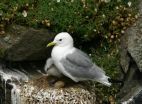(Press-News.org) TUCSON, Ariz. (January 4, 2011) -- Cumbersome glaucoma tests requiring a visit to the ophthalmologist could soon be history thanks to a home test developed by an engineer at the University of Arizona.
A new hand-held instrument involving a system of micro-force sensors, specially designed microchips, and math-based programmed procedures has been designed by researchers at the UA College of Engineering. The easy-to-use probe gently rubs the eyelid and can be used at home, threatening to replace painful eye drops and the need for a sterilized sensor.
"You simply close your eye and rub the eyelid like you might casually rub your eye," said Eniko Enikov, professor of aerospace and mechanical engineering and head of the Advanced Micro and Nanosystems Laboratory at the University of Arizona's College of Engineering. "The instrument detects the stiffness and, therefore, infers the intraocular pressure," Enikov said.
Work on the probe began four years ago in collaboration with Dr. Gholan Peyman, a Phoenix ophthalmologist. The instrument went through several years of refinement and modifications to arrive at the current design, a prototype instrument that's noninvasive and simpler than current procedures. It can also be used in situations that are difficult or impossible with current tests.
In addition to screening for glaucoma -- an eye disease that can lead to blindness if left untreated -- the device can be used to measure drainage of intraocular fluid. Patients could use the probe at home to trace how much the pressure decreases after using eye drop medications.
According to the Glaucoma Research Foundation, glaucoma is a leading cause of blindness. There is no cure, everyone is at risk, and there may be no symptoms to warn you. More than 4 million Americans have glaucoma but only half know they have it.
The development work was funded through the National Science Foundation, and Enikov and Peyman now are seeking investors to help fund final development and commercialization of the product.
"The innovation with our device is that it's noninvasive, simpler to use and applies to a variety of situations that are either difficult to address or impossible to test using the current procedures," Enikov said. "That's why we're so excited about this probe. It has great potential to improve medical care, and significant commercial possibilities, as well."
INFORMATION:
More information about the new glaucoma test instrument can be found at the University of Arizona College of Engineering website here
http://www.engr.arizona.edu/news/story.php?id=225
More on the Advanced Micro and Nanosystems Laboratory can be found here
http://nano.arizona.edu/
and more information on glaucoma, current research and treatments can be found here
http://www.glaucoma.org/
END
According to the Finnish Meteorological Institute's statistics, the mean annual temperature for the whole of Finland in 2010 was 1.3° C, which is 0.6 degrees below the long-term average. The last equally cold year took place in 1987, when the annual mean temperature was 0.1° C.
The annual mean temperatures for 2010 ranged from about 5° C in Southwest Finland to about
-3° C in Northern Lapland.
The average precipitation for the whole country was about 560 millimetres, which is about 30 millimetres less than normally. The highest annual precipitation was measured in ...
One of Britain's best known seabirds winters on opposite sides of the Atlantic depending on whether its breeding attempt has been successful according to new research published today in the journal Proceedings of the Royal Society B. The findings highlight previously unsuspected links between summer breeding performance and wintering distributions of kittiwakes.
The research team was led by Dr Maria Bogdanova from the Centre for Ecology & Hydrology (CEH) in conjunction with colleagues from CEH and the British Antarctic Survey (BAS).
The discovery of such patterns ...
A study led by the Smoking Control Unit of the Catalan Institute of Oncology (ICO) has confirmed that the anti-tobacco laws in Europe have a direct effect on the reduction in consumption and passive exposure to smoke. This conclusion was reached by relating the Tobacco Eurobarometer and the Tobacco Control Scale (TCS).
A new study, published in the magazine Plos One, has confirmed the hypothesis that the greater the restrictions, the lower the consumption and passive exposure to smoke. The study was carried out in the 27 countries of the EU and relates the Eurobarometer ...
Philadelphia, PA, 4 January 2011 - Normally, cortical nerve cells or neurons reside in the brain's gray matter with only a few scattered neurons in the white matter, but some people with schizophrenia have a higher number of neurons in the white matter. Neuronal migration errors may arise in schizophrenia as a consequence of both genetic and environmental factors.
The phenomenon of aberrant cellular localization has now been studied in detail in a paper by Yang and colleagues, published in the current issue of Biological Psychiatry.
Using a specialized technique that ...
Toronto – Growth is good, right?
Not always.
But compensation committees still tend to reward CEOs when their companies grow due to investments – even though that has been found to hurt long-term shareholder value – rather than only rewarding growth due to improved profitability, says a paper co-authored by a professor at the University of Toronto's Rotman School of Management.
The practice sends CEOs a message to grow at all costs, while hurting chances for companies to further improve shareholder value. Still, corporate boards may not realize what they're doing, ...
EAST LANSING, Mich. — In the first combat-zone study of its kind, a research team led by Michigan State University found that soldiers with a positive outlook in the most traumatic situations were less likely to suffer health problems such as anxiety and depression.
The study, which surveyed Army troops fighting in Iraq, could have implications for police officers, firefighters and others who regularly deal with traumatic events such as death. Training these first-responders to think in less catastrophic terms could help them better cope with distressing events and function ...
BOSTON – (January 4, 2011) With life expectancy increasing in Latin America, age-related disease has become a pressing public health concern. Results of an epidemiological study conducted by researchers at the Jean Mayer USDA Human Nutrition Research Center on Aging (USDA HNRCA) at Tufts University and the Corporacion Ecuatoriana de Biotecnologia showed that the metabolic syndrome, a condition that increases a person's risk of developing cardiovascular disease and type 2 diabetes, was prevalent in a low-income urban community in Ecuador and that a poor diet low in micronutrients ...
Atherosclerosis is the leading cause of death in the developed world. While a number of risk factors for atherosclerosis have been defined, scientists continue to study other possible risk factors for this disease. Recent epidemiological and experimental studies link infectious agents with the development of inflammatory atherosclerosis. A hallmark of chronic infection with the oral pathogen Porphyromonas gingivalis is the induction of a chronic inflammatory response. P. gingivalis induces a local inflammatory response that results in oral bone destruction, which is manifested ...
When faced with decisions, we often follow our intuition—our self-described "gut feelings"—without understanding why. Our ability to make hunch decisions varies considerably: Intuition can either be a useful ally or it can lead to costly and dangerous mistakes. A new study published in Psychological Science, a journal of the Association for Psychological Science, finds that the trustworthiness of our intuition is really influenced by what is happening physically in our bodies.
"We often talk about intuition coming from the body—following our gut instincts and trusting ...
New Rochelle, NY, January 4, 2011—Lowering the body temperature of patients soon after they have suffered a severe brain injury may reduce neurologic complications and improve outcomes. The safety of therapeutic hypothermia for traumatic brain injury (TBI) has been demonstrated in national studies. According to a Roundtable Discussion of renowned experts in the field, when and how it is administered should depend on the clinical condition of individual patients. The Roundtable was published online ahead of print in the new peer-reviewed journal Therapeutic Hypothermia and ...



